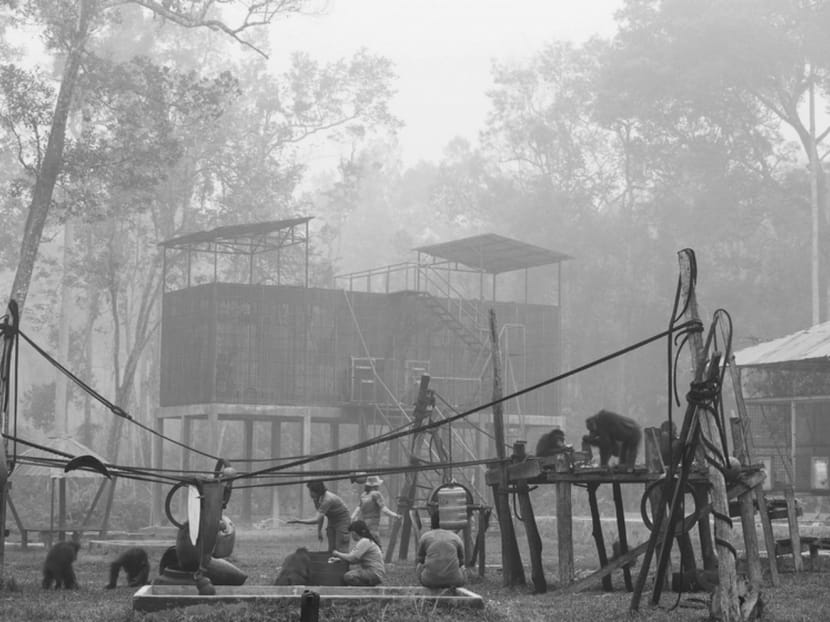How to keep up the pressure against haze
Singapore is starting to look like Beijing or New Delhi. That is because you cannot see it through the haze. Smog has disrupted outdoor events, forced schools to close and sent commuters running for their surgical masks.

Orangutans feed and play in a haze-covered playground at the Borneo Orangutan Survival Foundation near the central Kalimantan town of Palangkaraya on Friday. As bad as the air may be in Singapore or Kuala Lumpur, it’s positively apocalyptic in places like Kalimantan where the pollution index reached nearly 2,000 last month. Photo: Reuters
Singapore is starting to look like Beijing or New Delhi. That is because you cannot see it through the haze. Smog has disrupted outdoor events, forced schools to close and sent commuters running for their surgical masks.
Singaporeans know why. Every year during the dry season, farmers and plantation companies light fires on the Indonesian islands of Sumatra and Borneo to clear land for farming and for the production of paper and palm oil. Wind carries the smoke across the Malacca Strait and the South China Sea.
An especially bad episode in 1997 caused regional outrage and an estimated US$9 billion (S$12.8 billion) in economic damage. Nearly two decades later, in 2013, air pollution readings in Singapore and Malaysia topped 400 and 700, respectively. (Anything above 301 is considered hazardous.) An El Nino weather pattern this year has raised fears that smoggy skies could persist into 2016.
On paper at least, regional governments have finally heeded calls to do something about the problem.
Last year, Indonesia ratified an agreement that calls on countries to combat burning and share information. In May, the government extended a moratorium on clearing forests and peat land. Local laws are tough: Anyone responsible for setting fires can be sentenced to 15 years in jail and fined up to US$350,000. Singapore, where several big paper and palm-oil companies are headquartered, has established fines of up to S$2 million for corporations that enable or condone burning that pollutes the city-state.
Businesses have begun to regulate themselves. Many have adopted zero-deforestation pledges, while industry groups have established certification for sustainably produced palm oil, which is sold at a premium. Companies can also buy credits to offset their purchases of uncertified palm oil, thus funding what remains a niche market.
Haze measures need time
The challenges are obvious, of course. Many of these measures will need time to have an impact. Under Indonesia’s decentralised system, instituted in 2001, the central government has little sway at ground level, where local officials often profit from existing arrangements. Enforcement is weak.
Small-scale farmers may be responsible for much of the burning. Pinpointing the source of fires is complicated by overlapping land claims. Chasing down and arresting peasants would be time-consuming and fruitless. Indonesian authorities would be better off educating farmers about the dangers of burning and helping them pay for more expensive, alternate land-clearing techniques.
That hardly means the government is helpless, though. As bad as the air may be in Singapore or Kuala Lumpur, it is positively apocalyptic in places like the Indonesian province of Kalimantan, on Borneo, where a pollution index reached nearly 2,000 last month. The authorities could try encouraging local watchdog groups by increasing rewards for whistleblowers.
Prosecutors need to deter would-be scofflaws by winning more high-profile cases like the one that recently resulted in a US$25.6 million fine against the palm-oil company PT Kallista Alam, for setting fires in Aceh province. At the very least, the central government could help identify offenders by more readily supplying concession maps for a regional monitoring system, and speeding up plans to consolidate conflicting land-use maps into a single, accepted version.
Companies could do more, too. Even if they adhere to strict standards themselves, they face no penalties for failing to scrutinise how their suppliers conduct business, or how the land they buy was cleared.
Most effective of all might be a strategy to target these companies’ funding. Banks, sovereign wealth funds and private-equity investors could urge better behaviour by restricting their loans and investments to companies that adhere to environmental, social and governance standards that can be independently audited. Singapore’s Monetary Authority could have an immediate impact by establishing stewardship codes to guide investment decisions by local banks and government-linked entities.
Customers also have a role to play. They can demand better labelling of products that use palm oil to highlight those using sustainable producers. More countries could follow the lead of the Netherlands and the United Kingdom, which intend to import only sustainably-sourced palm oil.
At some point, this year’s haze will give way to blue skies. Only sustained pressure, from several angles, will keep it from returning. BLOOMBERG
ABOUT THE AUTHOR:
Nisid Hajari, who is based in Singapore, writes editorials on Asia. He was previously managing editor and foreign editor of Newsweek magazine, as well as managing editor of Newsweek International.






